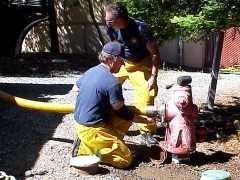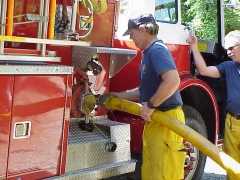© 2001 Capt. Willis Lamm, Water Supply Officer, Moraga-Orinda (CA) Fire District |
The following procedures are examples of low water pressure evolutions based on the procedures of the Moraga-Orinda Fire District, presented for illustrative purposes.When a large volume of water is not required a hydrant connection using 3 inch drafting hose (with 2½" couplings) will provide approximately 500 GPM and can be established in less time than using 4½" hose.
Prepare to pump Open the hydrant fully. If there is sufficient head, open the pony suction drain valve until the air in the hose has discharged. Close all drains and the tank to pump lines. Purge remaining air using the primer. There may still be trapped air in the suction hose so the pump may appear to have taken prime a couple of times before all air is expelled. Circulate water using the tank fill valve until ready to discharge into the supply line to the fire. This layout yielded about 500 GPM through one length of 3 inch hard suction hose. Return to Part 2
|
|
Unless otherwise noted, all contents of these WWW pages © 1996-2002, FireHydrant.org |

